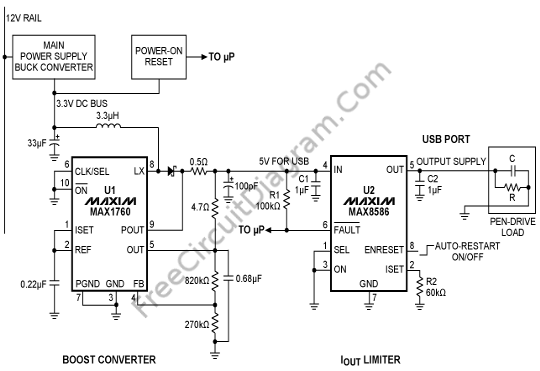Avoid Current Overshoot During USB Device Insertion

When you insert peripherals, a problem can occur : The sudden load on the port’s 5V pin usually isn’t purely resistive. This load has a capacitive component that can cause a rapid and high-amplitude rise in current to levels well above the 500mA limit for USB port.
When you connect a too-large hard disk to the port, a similar problem occurs. The capacitive load is not an issue; rather than disk’s normal operating may exceed 500mA. This can cause the system reset or cause the power supply to go into a protective mode. We usually add a protection device between the 5V supply and the port’s Vout pin to limit inrush current and restrict the maximum output current to 500mA.
To solve this problem, we can make a simple modification to the 5V boost converter circuit: A low-value resistor (0.5 Ohm) is inserted between the boost converter output and the resistive divider used for feedback. The voltage applied to the IOUT limiter (MAX8586) is independent of the 5V load current because the 5V converter now compensates for voltage drops across this resistor. The high and narrow current peaks that otherwise occur during the insertion of low-capacitance loads such as a pen drive (1µF) is prevented by this circuit. A system reset by overloading first the boost converter and then the 3.3V bus can be caused by a such current peaks. The 0.5 Ohm resistor not only limits peak currents to a reasonable value during the blindtime but also (following that condition) limits IOUT to 500mA maximum, as required by a USB port. [Source: MAXIM Application Note]